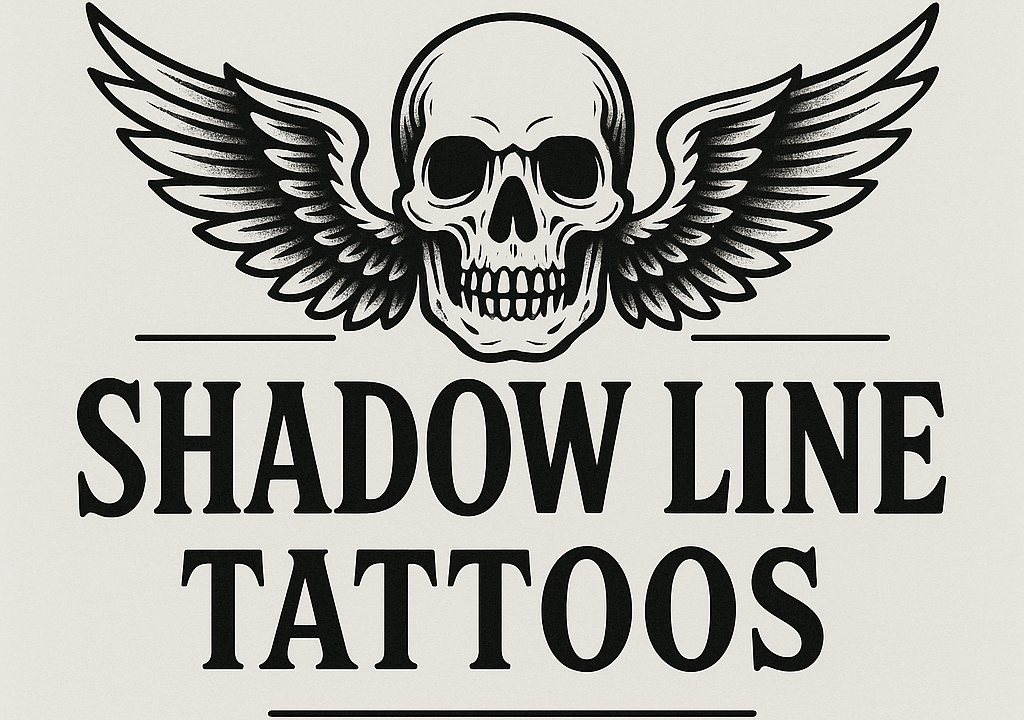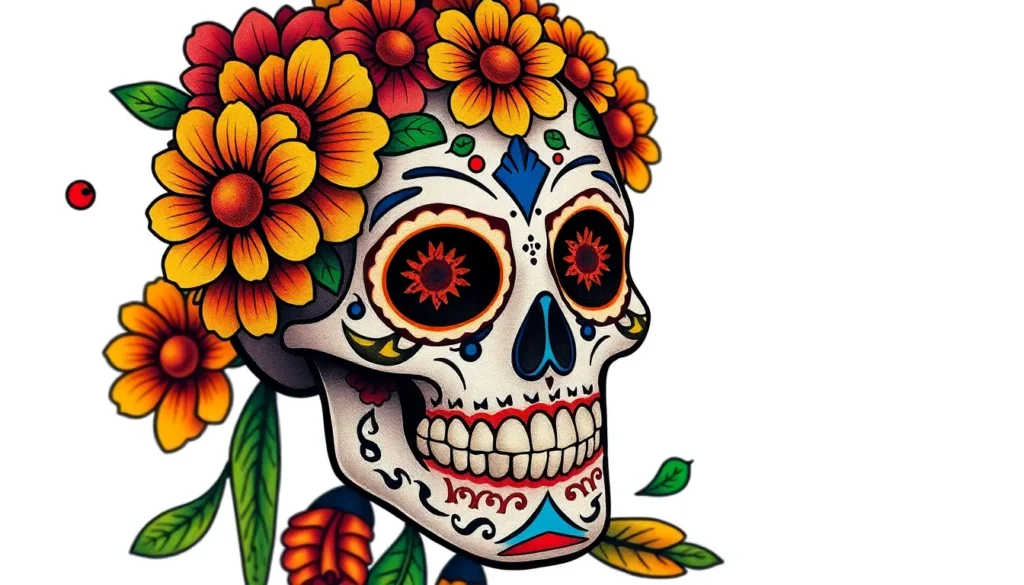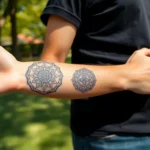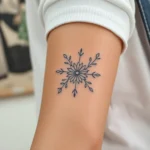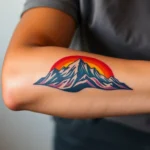Day of the Dead tattoos have exploded in popularity as people discover the rich symbolism and stunning artistry behind this Mexican tradition. We’re seeing more tattoo enthusiasts drawn to the vibrant sugar skulls, marigold flowers, and intricate designs that celebrate life rather than mourn death.
What makes these tattoos so captivating isn’t just their visual appeal—it’s the profound meaning they carry. Each element tells a story of remembrance, family bonds, and the beautiful cycle of life and death. From delicate calaveras adorned with roses to full sleeve pieces featuring dancing skeletons, these designs offer endless creative possibilities.
Whether you’re honoring a loved one or simply drawn to the artistic beauty of Día de los Muertos imagery, we’ve gathered the most inspiring tattoo ideas that capture the essence of this beloved celebration. Let’s explore designs that’ll help you wear this meaningful tradition with pride and style.
Traditional Sugar Skull Tattoo Designs
Sugar skull tattoos represent the heart of Day of the Dead artistry. These iconic designs serve as powerful symbols that honor departed loved ones while celebrating the beauty of life and death’s eternal cycle.
Classic Calavera Features
Calaveras showcase distinctive skeletal elements that define traditional sugar skull aesthetics. Empty eye sockets often feature decorative hearts, diamonds, or flower shapes that create visual depth. Nasal cavities typically display upside-down heart designs or simple triangular openings that maintain the skull’s recognizable silhouette.
Teeth patterns vary from realistic dental structures to stylized geometric arrangements. Artists frequently incorporate gold teeth, missing molars, or decorative dental work that adds personality to each calavera. Jawlines can feature subtle shading or bold outline work that emphasizes the skull’s bone structure.
Forehead decorations include cross symbols, spider web patterns, or ornate flourishes. These elements connect the design to spiritual traditions while adding visual interest to larger facial areas. Cheekbone details often feature small dots, lines, or geometric patterns that enhance the skull’s dimensional appearance.
Colorful Floral Decorations
Roses dominate traditional sugar skull floral arrangements with their deep symbolic meaning. Red roses represent passionate love and remembrance, while pink varieties symbolize gratitude and appreciation for departed family members. Purple roses add elements of enchantment and mystery to calavera designs.
Marigold flowers bring authentic Day of the Dead symbolism to sugar skull tattoos. These bright orange and yellow blooms traditionally guide spirits home during celebrations. Artists often incorporate marigold petals around eye sockets or create full crowns that frame the entire skull design.
Hibiscus and lily arrangements add tropical beauty to traditional calavera artwork. Blue hibiscus flowers represent peace and tranquility, while white lilies symbolize rebirth and renewal. These floral elements can wrap around the skull’s perimeter or cascade down the neck area.
Intricate Pattern Details
Lace patterns create delicate textures that soften the skull’s harsh bone structure. Doily-inspired designs around eye areas add feminine elegance to traditional calaveras. Intricate lacework can extend across cheekbones or create decorative borders around the entire skull outline.
Filigree scrollwork incorporates ornate metalwork aesthetics into sugar skull designs. These curving patterns often feature vine-like extensions that connect different decorative elements. Swirling filigree can fill empty spaces or create elaborate crowns above the skull’s forehead area.
Mandala elements bring spiritual geometry to traditional calavera artwork. Circular patterns centered on foreheads create focal points that draw viewers’ attention. These sacred designs can incorporate traditional Mexican motifs or blend with contemporary geometric tattoo styles.
Dia De Los Muertos Portrait Tattoos
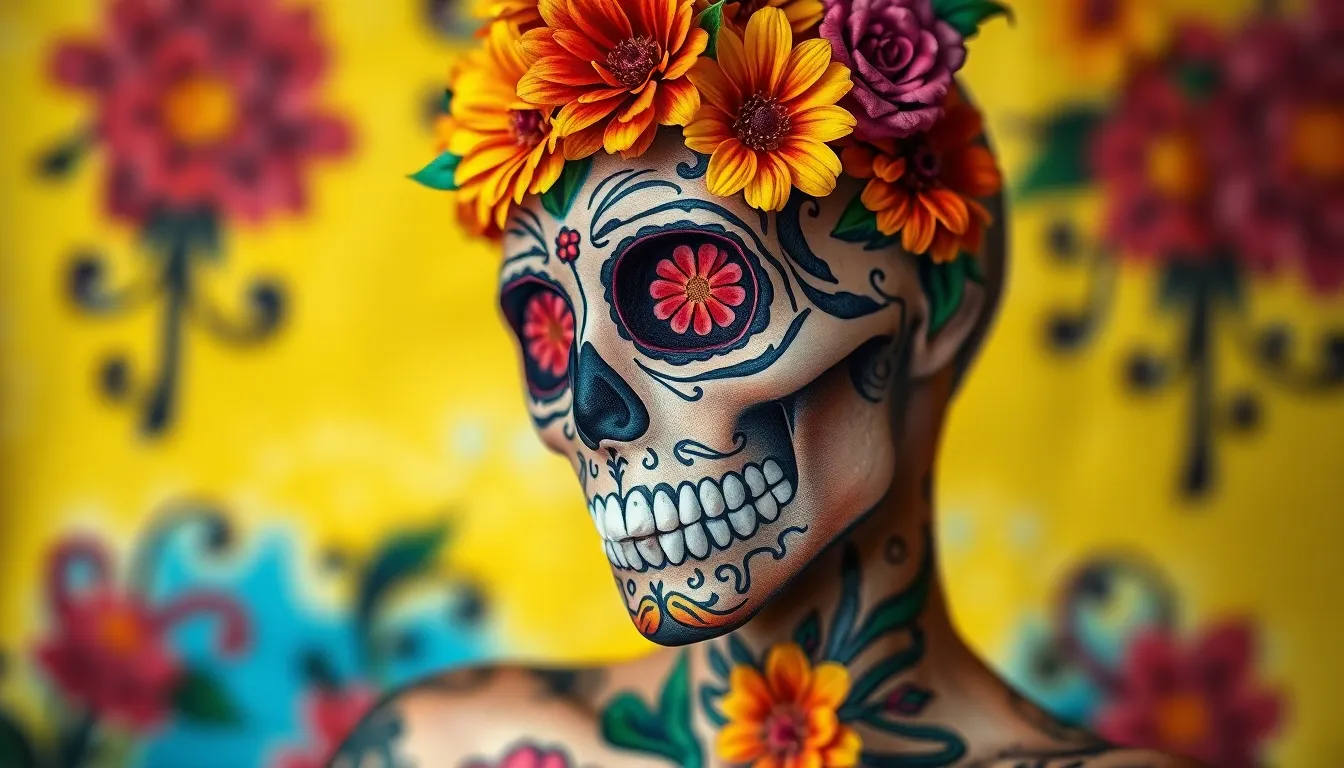
Portrait tattoos transform the traditional sugar skull into deeply personal tributes that honor exact individuals. We’ve seen these designs evolve from simple skeletal faces to complex artistic representations that capture both the essence of Day of the Dead symbolism and the unique characteristics of loved ones.
Family Member Memorial Portraits
Family memorial portraits blend authentic Dia de los Muertos imagery with personal remembrance in powerful ways. We often incorporate portraits of deceased family members directly into sugar skull designs, creating meaningful connections between traditional celebration and individual grief. Marigold flowers (cempasuchil) frequently surround these portraits because they’re believed to guide spirits back to the living industry during Day of the Dead festivities.
Names and important dates become integral design elements that emphasize the bond between living and deceased family members. We’ve noticed that watercolor techniques add vibrant life to these memorial pieces, while neo-traditional styles provide bold, lasting impact. Portrait placement typically centers around the heart, shoulder, or forearm where the tribute remains visible and close to daily life.
Celebrity Icon Interpretations
Celebrity interpretations offer unique twists on traditional Day of the Dead portraiture by blending popular culture with ancient Mexican traditions. We create these designs by reimagining famous figures through sugar skull aesthetics, incorporating floral motifs and skeletal elements into recognizable faces. Musicians, actors, and cultural icons receive the Day of the Dead treatment through artistic fusion that respects both the celebrity’s legacy and the holiday’s sacred meaning.
Artistic approaches vary from realistic portraits enhanced with calavera makeup to complete skeletal transformations that maintain the celebrity’s distinctive features. We recommend choosing figures who held personal significance or cultural impact to ensure the tattoo carries meaningful weight beyond visual appeal.
Pet Memorial Designs
Pet memorial tattoos adapt Day of the Dead symbolism to honor beloved animal companions through creative artistic interpretation. We design these pieces by incorporating pet portraits into sugar skull frameworks or surrounding animal images with traditional marigolds and decorative patterns. Personality traits exact to each pet influence the artistic choices, from playful butterflies for energetic dogs to elegant roses for regal cats.
Bone and floral combinations create touching tributes that celebrate the joy pets brought to our lives while acknowledging their passing. We’ve found that smaller, delicate designs work particularly well for pet memorials, allowing for placement on wrists, ankles, or behind ears where they serve as gentle daily reminders of unconditional love.
Marigold Flower Tattoo Combinations
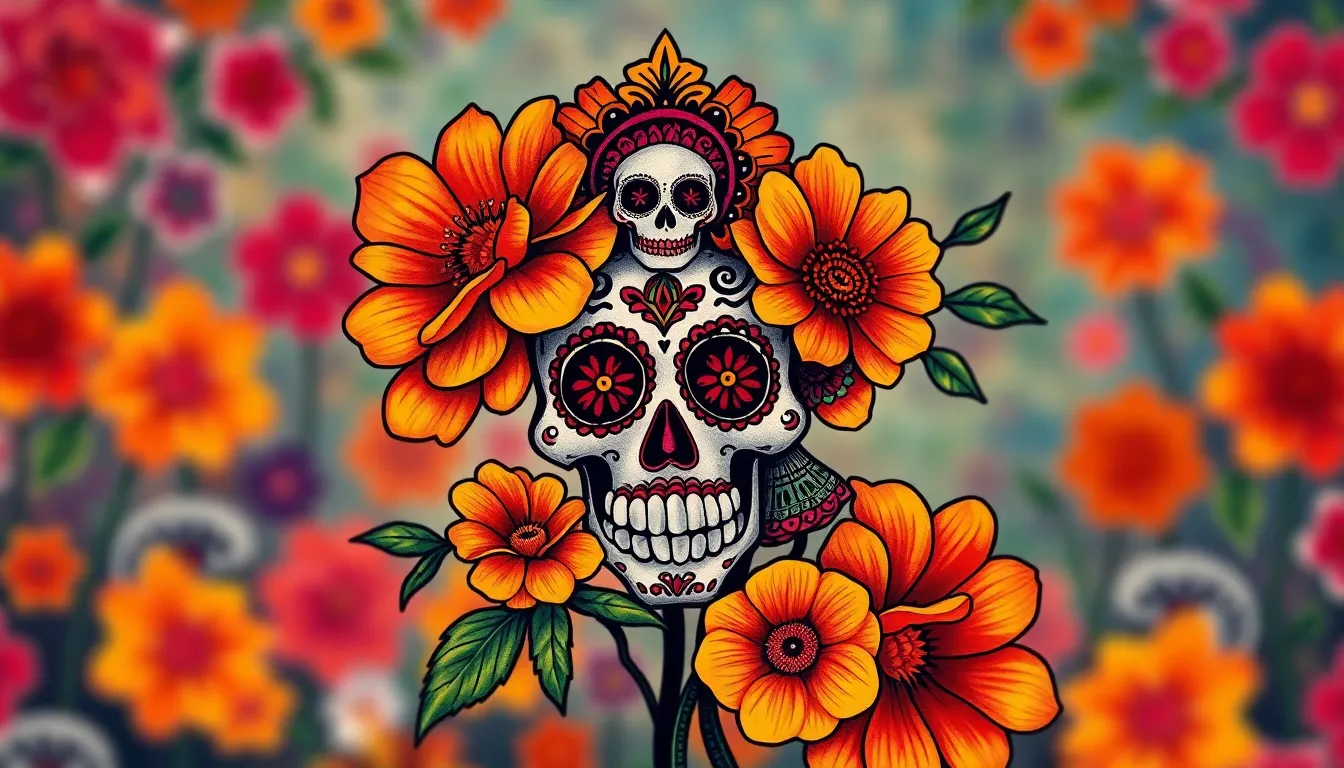
Marigolds serve as the cornerstone of authentic Day of the Dead tattoo designs, bringing vibrant orange and yellow hues that enhance cultural authenticity. These cempasúchil flowers create powerful visual narratives when combined with traditional elements like sugar skulls and La Catrina figures.
Cempasúchil Border Designs
Framing your main tattoo elements with cempasúchil borders creates an authentic connection to Day of the Dead rituals. These decorative frames typically surround sugar skulls, portraits, or La Catrina figures using repeating marigold motifs that draw the eye inward. Artists often interlace these borders with flowing vines or individual petals to create movement and organic flow. Traditional placement includes wrapping these borders around the upper arm, framing chest pieces, or creating circular frames for memorial portraits. Repeating flower patterns in these borders symbolize the continuous cycle of life and death while maintaining visual cohesion throughout larger tattoo compositions.
Flower Crown Arrangements
Sugar skulls and La Catrina figures gain dramatic impact when adorned with elaborate marigold flower crowns. These arrangements typically combine cempasúchil with roses, chrysanthemums, and other traditional blooms to create volume and visual interest. Artists design these crowns to frame the face of skull imagery, drawing attention upward while adding layers of symbolic meaning. Placement options include positioning crowns atop sugar skull foreheads, creating halos around La Catrina portraits, or designing asymmetrical arrangements that flow naturally with body contours. Color variations range from traditional bright oranges and yellows to sunset gradients that blend multiple warm tones for enhanced visual depth.
Scattered Petal Patterns
Creating movement and depth through scattered marigold petals transforms static tattoo designs into ever-changing compositions. These floating petals work as background elements or filler patterns, particularly effective in sleeve and leg tattoos where space allows for flowing designs. Artists strategically place individual petals to guide the viewer’s eye around central images like sugar skulls or memorial portraits. Watercolor techniques enhance these scattered patterns by blending petal edges into soft, organic transitions. Neo traditional styles emphasize bold petal outlines with vivid color fills, creating contrast against darker background elements and ensuring each petal maintains distinct visibility within the overall composition.
La Catrina Inspired Tattoo Art
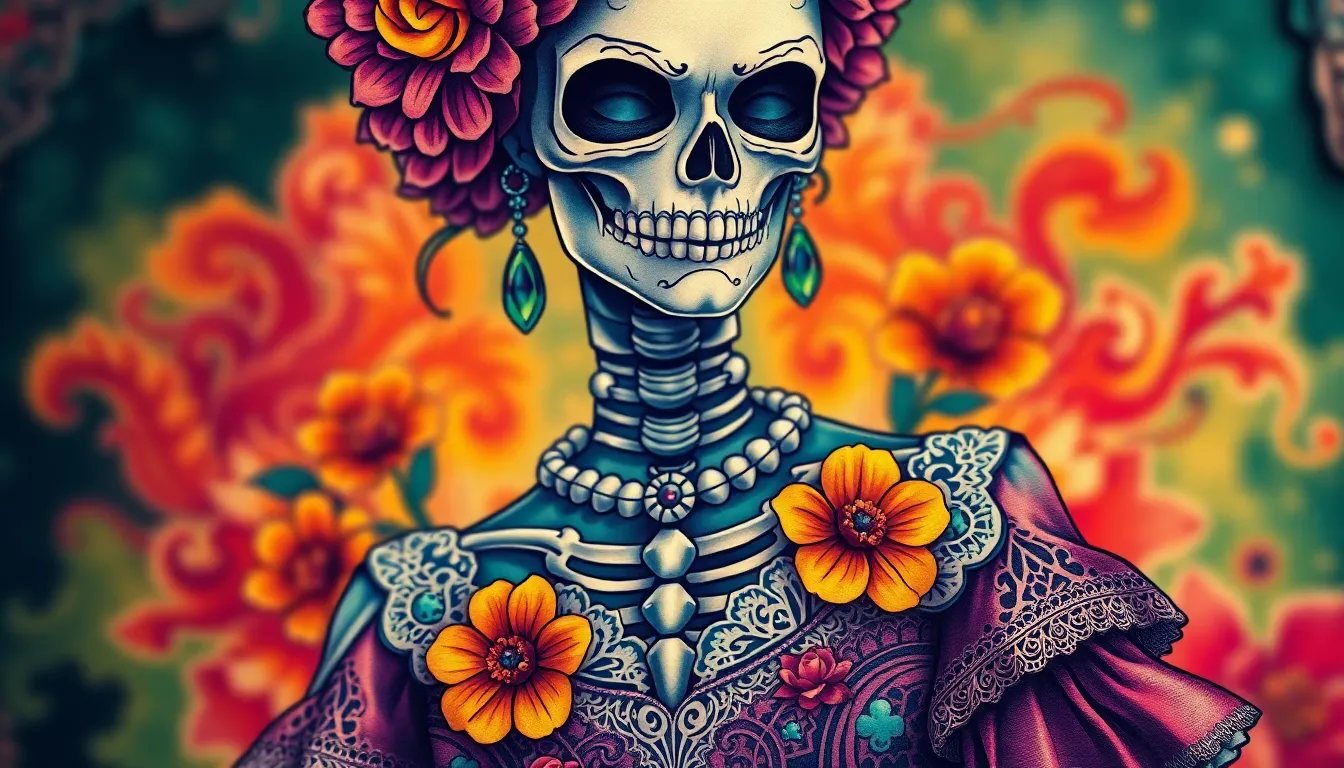
La Catrina represents the most iconic figure in Day of the Dead imagery, offering endless possibilities for stunning tattoo designs. We’ll explore three distinct approaches that capture her elegant essence while honoring Mexican cultural traditions.
Full Figure Elegant Lady
Full figure La Catrina tattoos showcase her complete Victorian-inspired elegance in breathtaking detail. These designs typically feature her wearing a formal dress with intricate lacework, flowing fabric, and ornate accessories that emphasize sophistication. Artists often incorporate marigold flowers cascading around her figure, creating a dramatic backdrop that connects to traditional Day of the Dead symbolism.
Large canvas areas like the back, thigh, or full sleeve work best for these elaborate compositions. We recommend including decorative elements such as roses, scrollwork, and delicate patterns woven throughout the dress fabric. Bold lines define her skeletal features while maintaining the graceful femininity that makes La Catrina so captivating.
Color palettes can range from vibrant traditional hues to elegant black and grey schemes. Neo-traditional styling enhances these full figure designs with rich purples, deep reds, and golden yellows that make the artwork truly pop against the skin.
Portrait Style Bust Designs
Portrait style La Catrina tattoos focus exclusively on her face and upper torso, allowing for incredible detail work. These designs emphasize her distinctive skull features, ornate flower crown, and the intricate patterns surrounding her eye sockets and forehead area. Artists can dedicate more attention to fine line work, creating elaborate filigree details and decorative flourishes.
Shoulder placements, upper arms, and chest areas provide ideal canvases for these portrait compositions. We often see marigold flowers incorporated directly into her hair or crown, creating seamless integration between the figure and traditional Day of the Dead elements. Delicate lacework patterns can frame her face, adding Victorian elegance to the overall design.
These bust style tattoos work exceptionally well in watercolor techniques, where soft color blending creates an ethereal quality. Artists frequently use pastel colors mixed with bold accents to achieve a modern aesthetic while respecting cultural authenticity.
Modern Catrina Interpretations
Modern La Catrina interpretations blend contemporary artistic elements with traditional imagery, creating fresh takes on this beloved figure. These designs might incorporate abstract backgrounds, geometric patterns, or bold color combinations that weren’t present in classic representations. Artists experiment with different styling approaches while maintaining her iconic essence and cultural significance.
Contemporary versions often feature updated fashion elements, modern makeup techniques, or artistic interpretations that reflect current tattoo trends. We see designs that combine traditional sugar skull features with modern portrait realism, creating hybrid styles that appeal to diverse artistic preferences. Bold color choices like electric blues, vibrant greens, and hot pinks can create striking visual impact.
These interpretations allow for creative freedom while still honoring the cultural heritage behind La Catrina. Artists might incorporate contemporary elements like urban backgrounds, modern floral arrangements, or stylized artistic effects that give the design a unique personal touch.
Day of the Dead Animal Tattoos
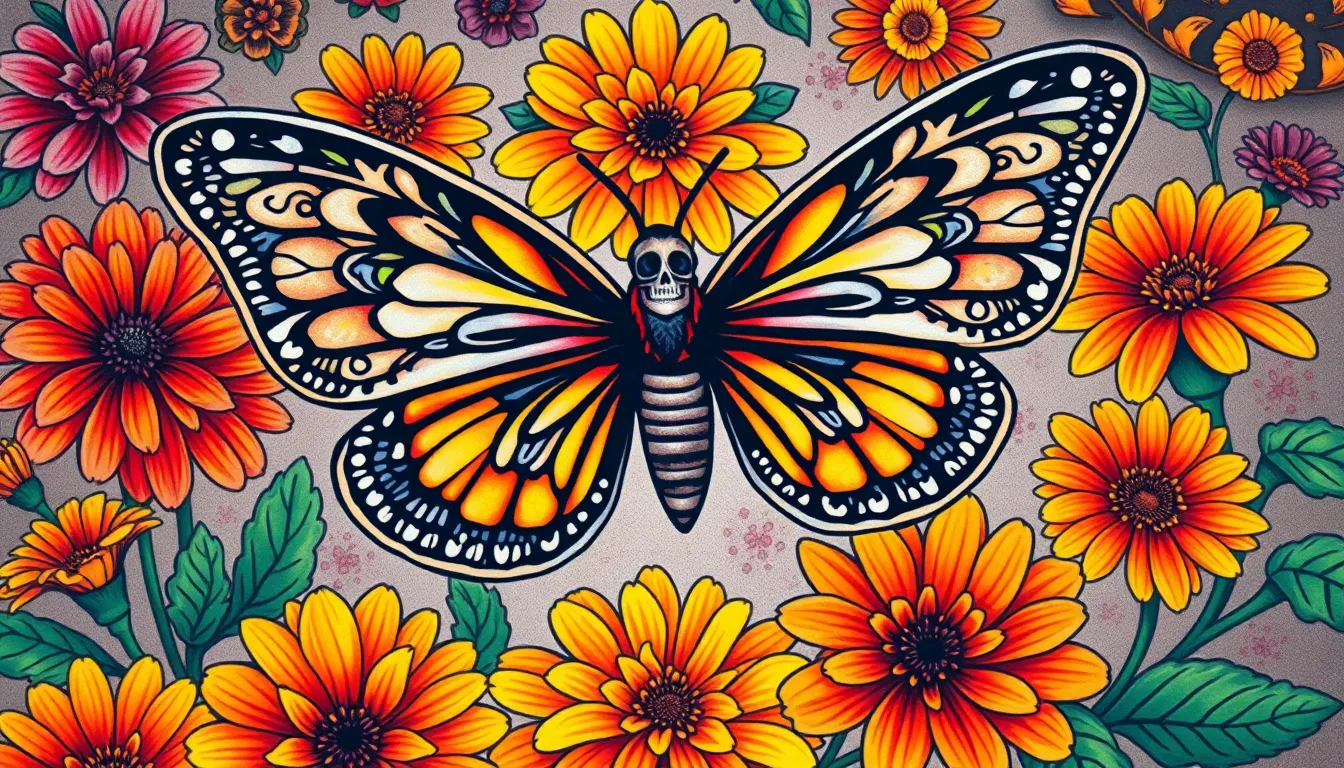
Animal motifs offer unique ways to honor both the spiritual journey and beloved companions through Day of the Dead imagery. These designs blend traditional symbolism with personal connections to create meaningful tributes.
Sugar Skull Butterflies
Sugar skull butterflies combine the iconic calavera design with delicate butterfly wings to represent transformation and the soul’s journey between worlds. These tattoos feature decorated skulls as the butterfly’s body while incorporating vibrant wing patterns filled with marigolds and traditional Day of the Dead colors.
Wings often showcase intricate lacework patterns or mandala designs that mirror the decorative elements found on classic sugar skulls. Artists frequently use bright oranges, purples, and yellows to create stunning wing gradients that complement the skull’s ornate features.
Placement options include shoulder blades where the wings can spread naturally or forearms where the vertical design creates striking visual impact. These tattoos work beautifully in both Neo-Traditional styles with bold colors and Black and Grey approaches for more subtle elegance.
Decorated Hummingbird Designs
Decorated hummingbird designs celebrate these tiny birds’ association with Day of the Dead traditions and their symbolic representation of souls traveling to the afterlife. Hummingbirds appear adorned with marigold flowers, creating vibrant tributes that honor deceased loved ones through nature’s beauty.
Artists often surround the hummingbird with cempasúchil petals or incorporate small sugar skull elements into the bird’s features. These designs frequently include trailing marigold garlands or scattered flower petals that add movement and spiritual significance to the composition.
Color palettes typically feature the traditional Day of the Dead spectrum with deep purples, bright oranges, and golden yellows that make the hummingbird appear to glow. Small memorial elements like dates or initials can be woven into the floral decorations for personal touches.
Memorial Pet Skulls
Memorial pet skulls transform beloved animal companions into Day of the Dead imagery while maintaining the celebration’s core message of honoring those who’ve passed. These tattoos incorporate pet skulls decorated with marigolds and traditional flowers to create touching tributes that blend personal loss with cultural celebration.
Artists customize these designs by adding exact pet characteristics like distinctive ear shapes for dogs or whisker patterns for cats. Names, dates, or favorite toys often appear integrated into the marigold decorations surrounding the skull.
Floral elements typically include roses for love and marigolds for guidance, creating a garden of remembrance around the pet’s likeness. These tattoos serve as permanent memorials that celebrate the joy pets brought to our lives while acknowledging the natural cycle of life and death.
Altar and Offrenda Tattoo Scenes
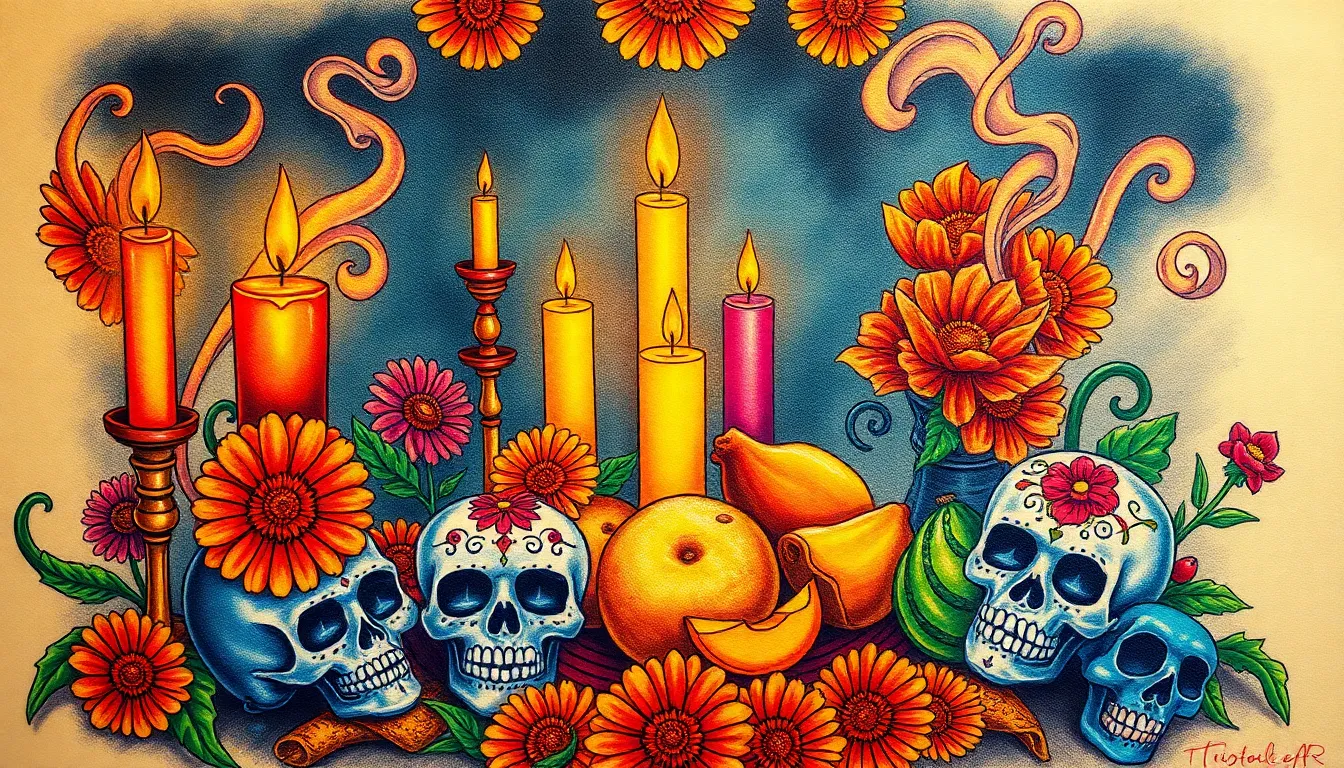
These intricate tattoo designs capture the sacred essence of Day of the Dead altars, transforming ceremonial offerings into permanent artwork that honors departed loved ones.
Traditional Altar Layouts
Traditional altar tattoos showcase the three level structure that forms the foundation of Dia de los Muertos celebrations. The bottom level serves as a memorial space for beloved pets, featuring small animal skulls or paw prints surrounded by marigold petals. Middle tier displays incorporate favorite foods and drinks of the deceased, including pan de muerto, fruits, and traditional beverages arranged in decorative patterns. Top level elements focus on photographs and personal mementos, often depicted as vintage frames or floating portraits within the tattoo composition.
Many artists simplify these complex layouts into flowing designs that wrap around arms or legs, creating a continuous narrative of remembrance. Geometric patterns connect each altar level, using dotwork or line art to represent the spiritual journey between worlds. Personal symbols replace traditional items, allowing individuals to customize their altar tattoos with meaningful objects that reflect their loved ones’ personalities.
Candle and Incense Elements
Candle imagery represents the guiding light that helps spirits find their way back to the living industry during Day of the Dead celebrations. Flickering flame details create movement within tattoo designs, often surrounded by smoke patterns that blend seamlessly with sugar skull artwork. Multiple candles arranged in circular patterns form powerful focal points, especially when combined with marigold flowers and decorative skulls.
Incense elements add spiritual depth to altar tattoos through swirling smoke designs that purify the sacred space. Copal incense burners appear as ornate vessels filled with aromatic offerings, their smoke creating ethereal backgrounds for portrait work. Smoke patterns weave through other tattoo elements, connecting candles to flowers and creating visual flow that represents the bridge between physical and spiritual realms.
Artists often combine both elements into cohesive altar scenes, using negative space and shading techniques to suggest the warm glow of candlelight. Sacred geometry patterns emerge from smoke and flame designs, incorporating traditional Mexican art motifs that enhance the cultural authenticity of the tattoo.
Food Offering Displays
Food offering tattoos celebrate the festive abundance that characterizes Day of the Dead altars, featuring traditional dishes arranged in colorful displays. Pan de muerto appears as detailed bread loaves decorated with bone shaped patterns, often positioned alongside sugar skulls and marigold arrangements. Fresh fruits create vibrant accents within altar compositions, including oranges, apples, and bananas that represent the sweetness of life and memory.
Favorite dishes of deceased family members transform into personalized tattoo elements, allowing individuals to honor exact culinary traditions and cultural heritage. Tamales, mole, and other regional specialties appear alongside traditional offerings, creating unique altar scenes that reflect family history. Decorative plates and serving dishes add ornate frames around food elements, incorporating patterns inspired by Mexican ceramics and folk art.
Table arrangements showcase multiple food items in balanced compositions, using perspective and shading to create depth within the tattoo design. Skull faced chefs or La Catrina figures often preside over these food displays, adding personality and cultural significance to the overall altar scene.
Mexican Folk Art Tattoo Elements
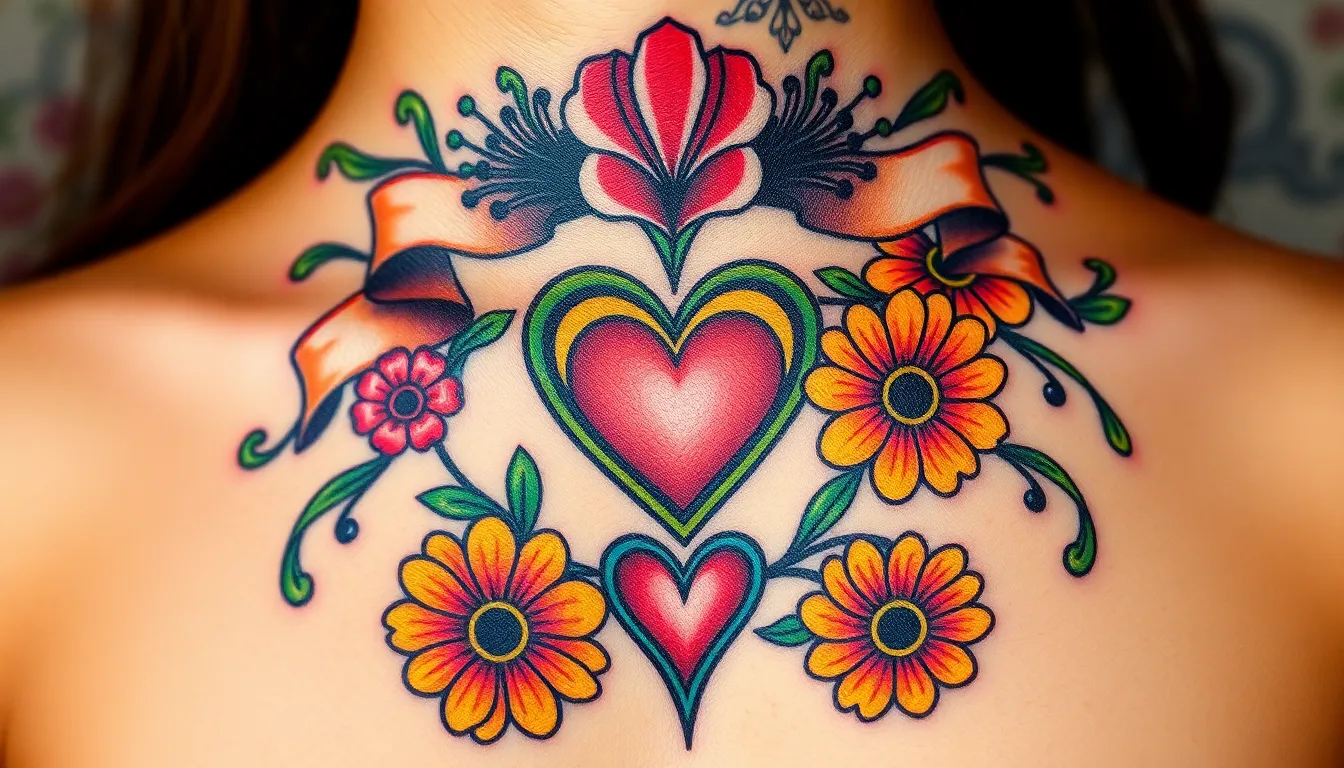
Beyond sugar skulls and marigolds, Day of the Dead tattoos draw from a rich tapestry of Mexican folk art traditions. These decorative elements add authentic cultural depth and visual interest to memorial designs.
Papel Picado Banner Designs
Papel picado transforms Day of the Dead tattoos into festive celebrations of life through delicate tissue paper artistry. These colorful cut-outs feature intricate patterns that dance across the skin, often depicting skulls, hearts, or traditional geometric motifs in vibrant hues. Artists frequently incorporate papel picado as decorative borders around larger elements like La Catrina portraits or sugar skulls, creating a frame that celebrates rather than mourns.
The flowing nature of papel picado banners adds movement to static tattoo designs, with each perforated section telling part of the story. Symbolic banners work especially well in sleeve designs where multiple papel picado pieces can cascade down the arm, each featuring different Day of the Dead motifs that honor exact family members or memories.
Sacred Heart Symbols
Sacred Heart imagery weaves Catholic devotion into Day of the Dead tattoo designs, reflecting Mexico’s blended spiritual traditions. This powerful symbol represents eternal love and remembrance for the deceased, often appearing as a glowing element within larger compositions. The heart typically features radiating light, thorns, or flames that add dramatic visual impact while conveying deep emotional significance.
Cultural blend becomes evident when Sacred Heart symbols appear alongside indigenous Day of the Dead elements like marigold flowers or skull imagery. Artists often place the Sacred Heart at the center of altar scene tattoos, surrounded by candles, flowers, and photographs to create a complete memorial composition that honors both Catholic faith and ancestral traditions.
Cross and Religious Imagery
Cross designs in Day of the Dead tattoos honor the blend of traditions that defines Mexican spiritual culture. These religious symbols serve as protective elements while acknowledging the Catholic influence on indigenous death celebrations. Ornate crosses often feature decorative flourishes, floral engravings, or small skull details that connect them directly to Day of the Dead themes.
Protection and faith intertwine when crosses appear alongside other folk art elements like papel picado or marigold garlands. Artists frequently incorporate multiple cross styles within single designs, from simple wooden crosses reminiscent of cemetery markers to elaborate gothic crosses that echo colonial Mexican architecture, creating tattoos that reflect the full spectrum of Mexican religious heritage.
Black and Gray Day of the Dead Tattoos
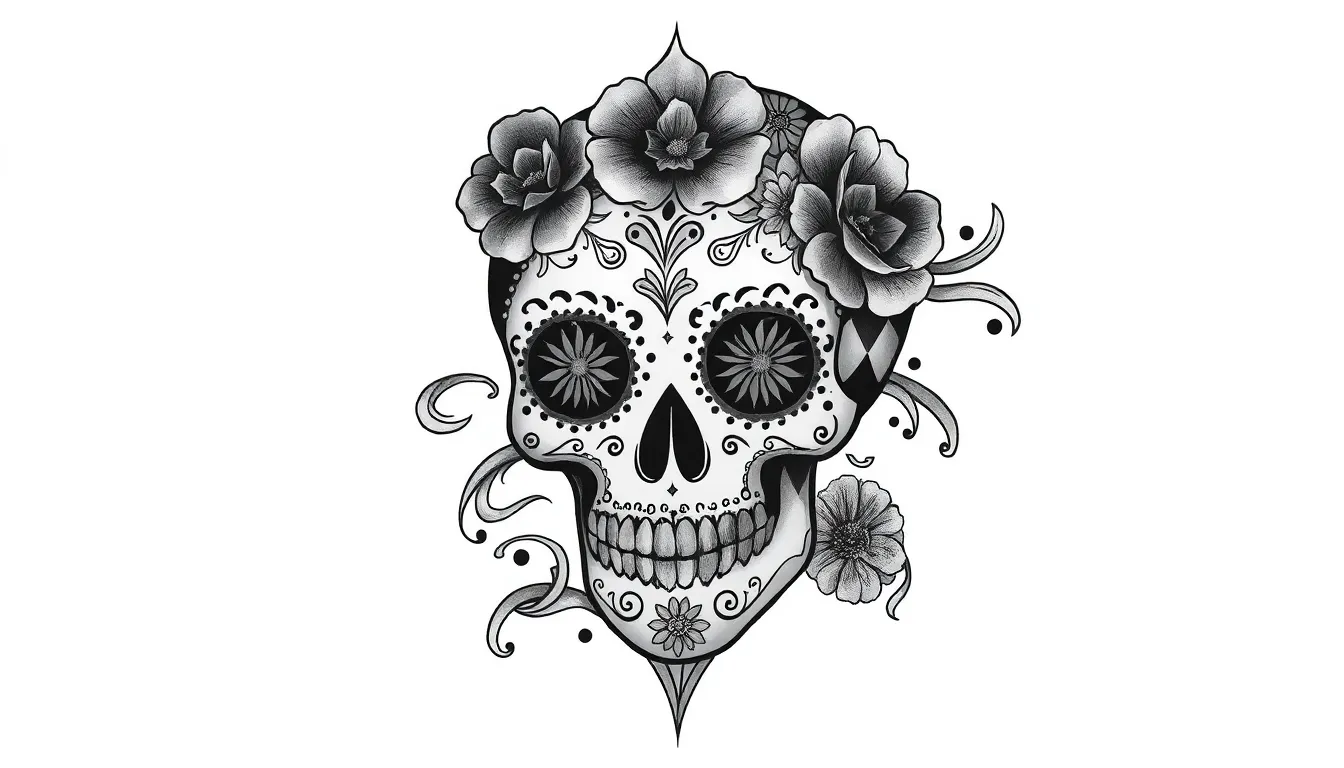
Black and gray Day of the Dead designs offer timeless elegance while maintaining cultural authenticity through their monochromatic beauty.
Monochromatic Sugar Skulls
Stylized sugar skulls create stunning visual impact through intricate details rendered entirely in shades of gray. These designs feature decorative flowers or filigree patterns that add depth without requiring color, emphasizing the artistic craftsmanship through careful shading techniques. Minimalist approaches focus on bold lines and subtle texture variations, creating striking designs that capture attention through simplicity rather than complexity.
Traditional calavera elements translate beautifully into grayscale compositions, where ornate eye sockets and decorative teeth patterns gain prominence through contrast and shadow work. Artists often incorporate lacework details and mandala inspired patterns using various gray tones to create visual interest and cultural authenticity.
Shaded Portrait Styles
Realistic portraits bring emotional depth to Day of the Dead tattoos through expertly executed shading techniques that honor loved ones or cultural figures. La Catrina portraits benefit particularly from this approach, where her Victorian elegance emerges through careful gradations of black and gray ink. These designs often blend sugar skull elements with realistic facial expressions, creating powerful memorial pieces that celebrate both individual remembrance and cultural tradition.
Intricate facial details allow artists to showcase technical skill while maintaining the spiritual significance of the imagery. Portrait styles can incorporate family member likenesses surrounded by traditional motifs like marigold outlines or papel picado patterns, all rendered in monochromatic tones that emphasize the eternal nature of memory.
Detailed Line Work Designs
Intricate patterns showcase the artistic complexity possible within black and gray compositions, featuring traditional Day of the Dead motifs like marigold flowers and ceremonial elements. These designs emphasize line weight variations and crosshatching techniques to create texture and visual depth without relying on color. Complex geometric elements can integrate seamlessly with cultural symbols, adding modern appeal while respecting traditional significance.
Traditional altar elements translate effectively into detailed line work, where candles, incense, and food offerings become part of larger compositions through careful pattern integration. Artists often combine multiple design elements using various line techniques, creating cohesive pieces that tell complete stories about family heritage and cultural celebration through masterful black and gray execution.
Watercolor Day of the Dead Tattoos
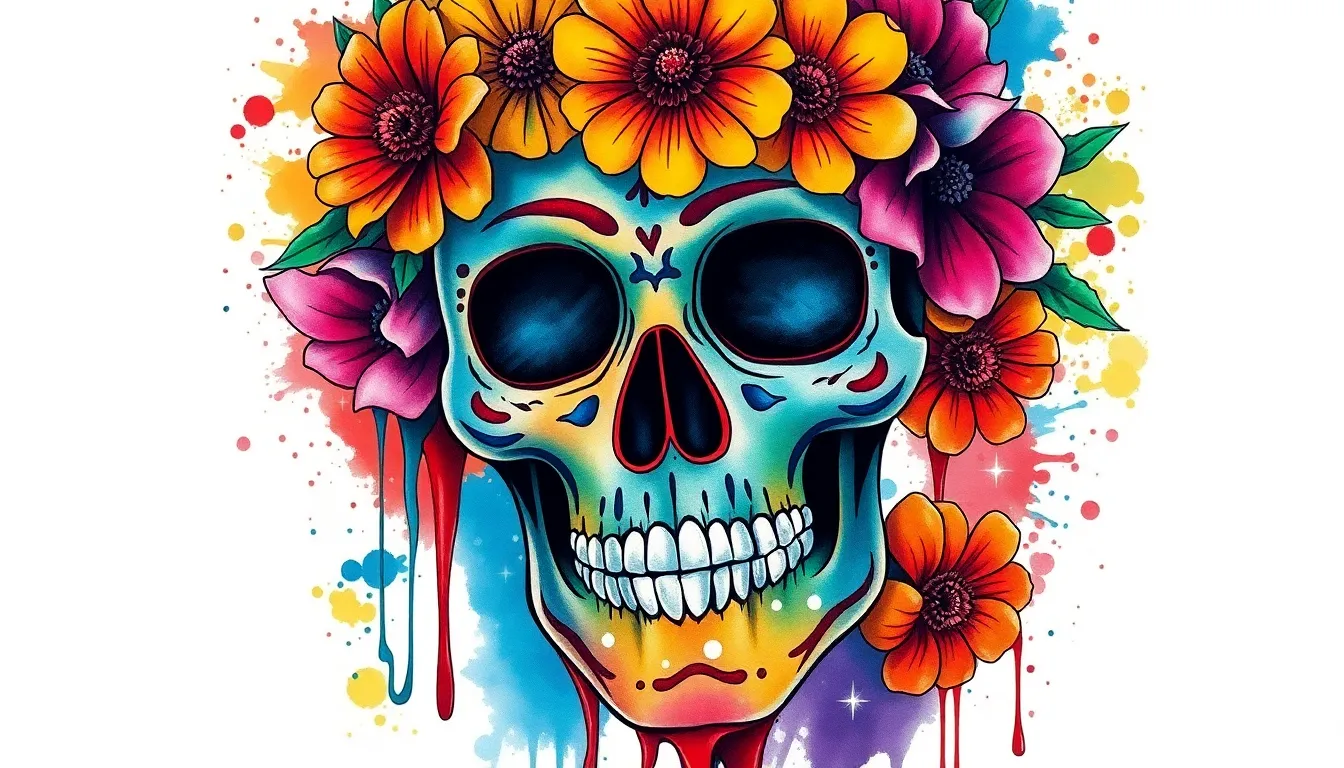
Watercolor techniques bring a dreamy, ethereal quality to Day of the Dead imagery that perfectly complements the celebration’s blend of mourning and joy. Artists use soft color blending and fluid brushstroke effects to create sugar skulls and marigold flowers that appear to bloom directly on the skin.
Splashed Color Backgrounds
Splashed color backgrounds create stunning visual impact by surrounding traditional Day of the Dead elements with vibrant, organic color bursts. Artists achieve this effect by incorporating watercolor techniques that mimic paint being splashed or thrown onto canvas. Sugar skulls emerge from these colorful backgrounds like spirits materializing from the afterlife celebration.
Marigold oranges, deep purples, and bright pinks typically dominate these splashed backgrounds, creating the festive atmosphere of Dia de los Muertos. La Catrina portraits benefit enormously from this technique, as the splashed colors can represent the flowers and decorations surrounding altars and ofrendas. Color placement appears random yet purposeful, with artists strategically positioning splashes to enhance rather than overwhelm the main tattoo elements.
Bleeding Ink Effects
Bleeding ink effects add movement and emotion to Day of the Dead tattoos by creating the appearance of colors flowing beyond their intended boundaries. This technique works exceptionally well with sugar skull designs, where colors appear to weep or flow from the eye sockets and decorative patterns. Artists use diluted inks and strategic water application to achieve these organic bleeding patterns.
Marigold petals benefit from bleeding ink techniques, as the colors naturally transition from deep orange centers to lighter yellow edges. Memorial portraits incorporating this style suggest the eternal nature of memory, with colors bleeding beyond the physical form to represent lasting spiritual connections. Bleeding effects work particularly well around roses and other floral elements, creating soft transitions that mirror the gentle passage between life and death.
Artistic Paint Drip Styles
Artistic paint drip styles incorporate deliberate dripping effects that add vertical movement and contemporary flair to traditional Day of the Dead imagery. Artists create these drips using watercolor techniques that allow gravity to pull colors downward in natural, uncontrolled patterns. Sugar skulls adorned with paint drips appear to be actively decorated with fresh paint, celebrating the ongoing nature of remembrance.
Color drips typically originate from the most decorated areas of the tattoo, such as flower crowns or ornate eye sockets, creating visual weight that draws the eye downward. La Catrina designs benefit from paint drip effects around her elaborate hat decorations, with colors cascading down to frame her elegant features. Artists often incorporate multiple colors in their drip effects, allowing marigold oranges to blend with purple shadows and bright accent colors as they flow across the skin.
Small and Minimalist Tattoo Ideas
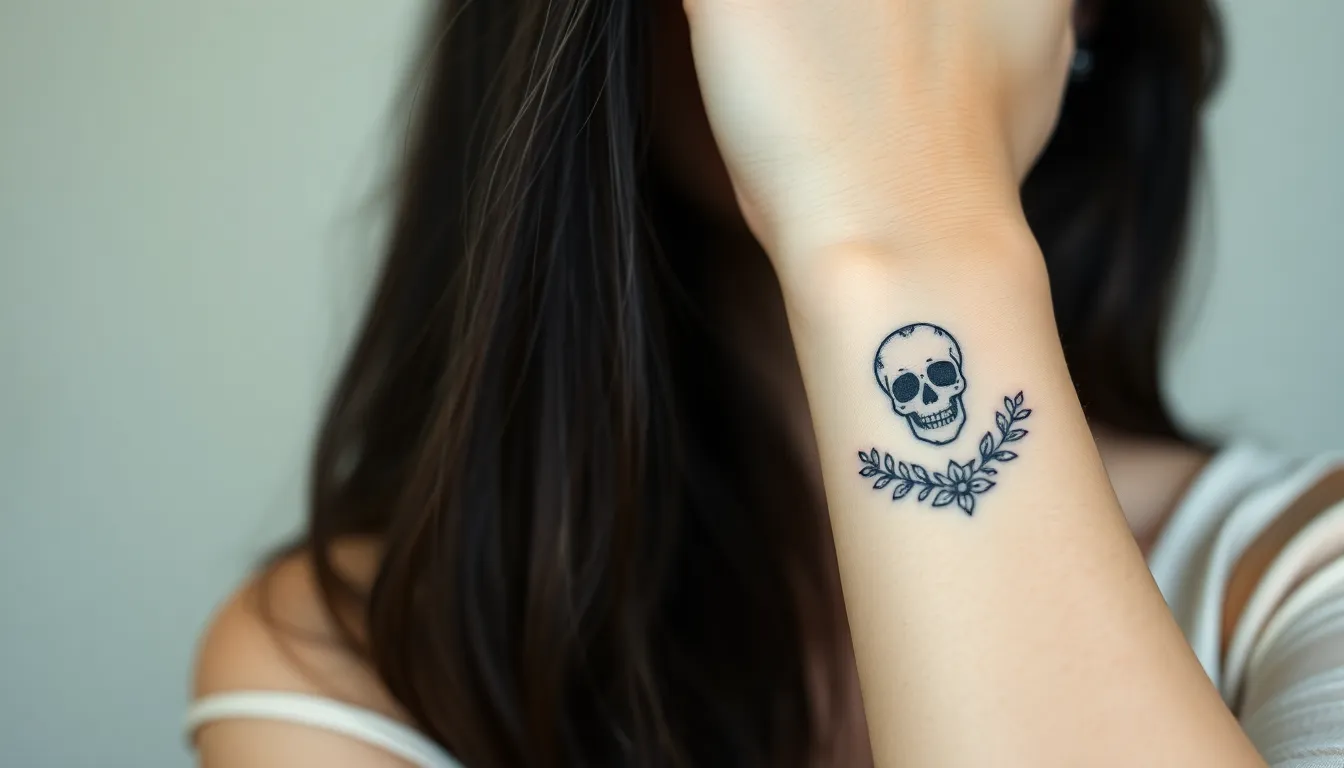
Not everyone wants a large, elaborate Day of the Dead tattoo, and we understand that subtle elegance can be just as meaningful. These compact designs capture the essence of Dia de los Muertos while fitting perfectly into your lifestyle and personal aesthetic.
Tiny Sugar Skull Designs
Mini sugar skulls pack incredible symbolism into surprisingly small spaces. We love how these designs focus on the iconic calavera shape while incorporating minimal floral elements or decorative patterns around the eyes and forehead areas. Placement options like wrists, ankles, or behind the ear make them perfect for first time tattoo enthusiasts or those seeking discreet body art.
Sugar skull bitings offer a unique twist on traditional designs. These tiny tattoos feature a sugar skull with a bite mark removed, symbolizing life’s fragility and the natural cycle of existence. Fingers, hands, or small areas behind the collarbone work beautifully for these conversation starting pieces.
Minimalist skulls surrounded by simple flower patterns create balanced compositions. We recommend placing these designs on areas where the natural curves of your body enhance the artwork’s flow, such as the shoulder blade or ankle bone.
Simple Flower Outlines
Marigold outlines capture the spiritual significance of cempasuchil flowers in their purest form. These delicate designs guide departed spirits back to the living industry according to Mexican tradition. Single stem outlines work perfectly on wrists or forearms, while clustered arrangements suit larger areas like the shoulder or upper back.
Dainty rose outlines add romantic symbolism to Day of the Dead imagery. We often see these paired with small skull elements or used as standalone pieces representing love and remembrance. The natural curves of roses complement body contours beautifully, especially along the ribcage or collarbone area.
Scattered petal patterns create movement without overwhelming smaller tattoo spaces. These designs work exceptionally well as connecting elements between other Day of the Dead tattoos or as subtle standalone pieces on areas like the inner wrist or ankle.
Delicate Symbol Tattoos
La Catrina silhouettes capture the elegance of this iconic figure through minimalist line work. We love how these designs maintain her recognizable Victorian inspired profile while remaining small enough for discreet placement. Upper arms, shoulders, or the back of the neck showcase these silhouettes beautifully.
Symbolic cempasuchil petals connect you to the celebration’s spiritual essence through simple, elegant forms. These delicate designs often feature individual petals or small clusters that can be placed strategically on areas like the neck, behind the ear, or on the inner wrist. The organic shapes of marigold petals flow naturally with your body’s contours.
Single candle flame outlines represent the guiding light for departed souls. We recommend these minimal designs for areas where the flame’s upward movement complements your body’s natural lines, such as along the forearm or behind the ear.
Conclusion
Day of the Dead tattoos offer us a beautiful way to honor our loved ones while celebrating the rich traditions of Mexican culture. Whether we choose vibrant watercolor designs or elegant black and gray pieces we’re creating lasting tributes that hold deep personal meaning.
These tattoos remind us that death isn’t an end but a continuation of love and memory. From delicate minimalist symbols to elaborate altar scenes each design tells a unique story of remembrance and celebration.
As we embrace this meaningful art form we’re not just getting tattoos – we’re participating in a tradition that beautifully bridges the gap between life and death while keeping our cherished memories alive forever.
Frequently Asked Questions
What do Day of the Dead tattoos symbolize?
Day of the Dead tattoos symbolize the celebration of life and remembrance of departed loved ones. They represent the eternal cycle of life and death, honoring family connections while embracing Mexican cultural heritage. These tattoos serve as permanent memorials that blend personal significance with traditional symbolism.
What are the most popular elements in Day of the Dead tattoos?
The most popular elements include sugar skulls (calaveras), marigold flowers, La Catrina figures, and altar scenes. Other common features are decorated butterflies, hummingbirds, religious symbols like crosses and Sacred Hearts, and papel picado patterns that add festive movement to designs.
Can Day of the Dead tattoos be personalized for family members?
Yes, Day of the Dead tattoos can be highly personalized by incorporating portraits of deceased family members, beloved pets, or meaningful personal symbols. These memorial designs often blend traditional imagery with individual remembrance, creating unique tributes that honor specific relationships and memories.
What’s the significance of marigold flowers in these tattoos?
Marigold flowers (cempasúchil) are essential Day of the Dead symbols believed to guide spirits back to the world of the living. In tattoos, they represent the connection between life and death, often used as borders, crowns, or scattered petals to enhance the visual narrative and cultural authenticity.
Are small Day of the Dead tattoos as meaningful as larger ones?
Absolutely. Small and minimalist Day of the Dead tattoos capture the same cultural essence and personal significance as larger pieces. Tiny sugar skulls, simple marigold outlines, or delicate La Catrina silhouettes offer meaningful options while fitting seamlessly into personal aesthetics and lifestyles.
What’s the difference between traditional and modern Day of the Dead tattoo styles?
Traditional styles focus on authentic cultural elements like classic calaveras and religious symbols, while modern interpretations blend contemporary artistic techniques with traditional imagery. Modern designs might incorporate watercolor effects, abstract elements, or bold colors while maintaining cultural significance and respect.
Can Day of the Dead tattoos include animals?
Yes, animal designs are popular in Day of the Dead tattoos. Sugar skull butterflies symbolize transformation, decorated hummingbirds represent souls traveling to the afterlife, and memorial pet skulls honor beloved companions. These designs blend spiritual symbolism with personal connections to animals.
What tattoo styles work best for Day of the Dead designs?
Various styles work well, including traditional black and gray for timeless elegance, vibrant color work for authentic cultural representation, and watercolor techniques for dreamy artistic effects. The choice depends on personal preference, design complexity, and the specific elements being incorporated into the tattoo.
